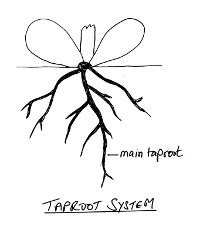- taproot system
- fibrous root system
TAPROOT SYSTEM
 Most plants develop a TAPROOT system. It is characterised by a tapering central structure from which lateral roots branch off. Sometimes, this type of root consists principally of a long, thick main taproot to store food reserves (e.g. dandelion); and sometimes this is thickened even more and has less lateral roots (e.g.carrot, beets).
Most plants develop a TAPROOT system. It is characterised by a tapering central structure from which lateral roots branch off. Sometimes, this type of root consists principally of a long, thick main taproot to store food reserves (e.g. dandelion); and sometimes this is thickened even more and has less lateral roots (e.g.carrot, beets).Taproots are useful to access deep water and food reserves, and also to anchor tall plants, such as conifers.
FIBROUS ROOT SYSTEM
 Fibrous roots systems are characterised by shallower roots of even thickness and profuse branching (e.g. grass roots). This gives an enormous surface area with which to extract water and nutrients. These roots are also good at preventing wind and water erosion, since they come into such intimate contact with the soil particles.
Fibrous roots systems are characterised by shallower roots of even thickness and profuse branching (e.g. grass roots). This gives an enormous surface area with which to extract water and nutrients. These roots are also good at preventing wind and water erosion, since they come into such intimate contact with the soil particles.ADVENTITIOUS ROOTS
In monocots (such as grasses) the primary root dies and ADVENTITIOUS roots grow out of the stem ('adventitious growth' means 'growing out of place'). Shoot tip and leaf cuttings also develop this type of root.
Onions and other bulbs have fibrous roots which are also adventitious, since, as we have seen, a bulb is a compressed shoot. It doesn't half get complicated? But fortunately, you don't really need to know all this to grow plants well.
Note: Quite often it is not easy to determine whether a root is a highly branched taproot, or a fibrous root.
No comments:
Post a Comment